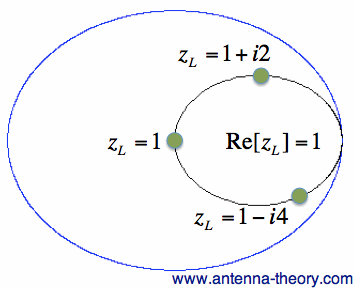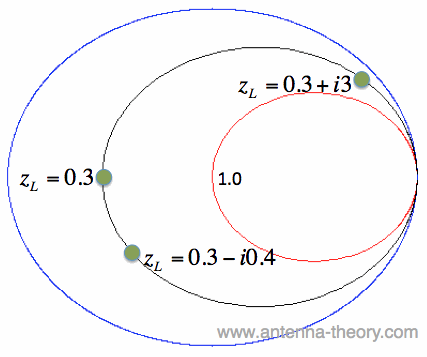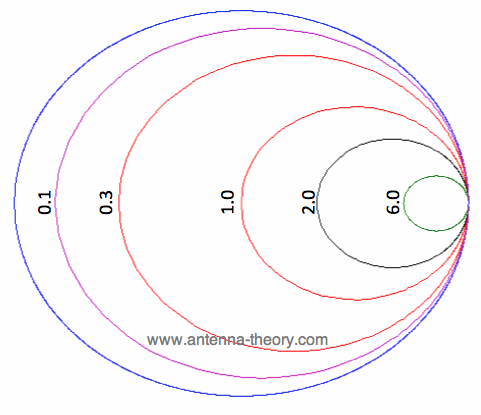Smith Chart: Constant Resistance Circles
|
On this page, we'll start filling in the Smith Chart, to understand where all the complicated curves
come from on the Smith Chart (See Figure 1 on the intro to Smith Chart Page).
Before we jump in to that, let's define normalized impedance.
Normalized Load ImpedanceTo make the Smith Chart more general and independent of the characteristic impedance Z0 of the transmission line, we will normalize the load impedance ZL by Z0 for all future plots:
 [1] [1]
Equation [1] doesn't affect the reflection coefficient (
Constant Resistance CirclesOn the previous page, we did examples of plotting values of on the Smith Chart. Similarly, for a given normalized load impedance zL, we can determine
on the Smith Chart. Similarly, for a given normalized load impedance zL, we can determine  and plot it on the Smith Chart.
and plot it on the Smith Chart.Now, suppose we have the normalized load impedance given by:
 [2] [2]In equation [2], Y is any real number. What would the curve corresponding to equation [2] look like if we plotted it on the Smith Chart for all values of Y? That is, if we plotted z1 = 1 + 0*i, and z1 = 1 + 10*i, z1 = 1 - 5*i, z1 = 1 - .333*i, .... and any possible value for Y that you could think of, what is the resulting curve? The answer is shown in Figure 1:
 Figure 1. Constant Resistance Circle for zL=1 on Smith Chart. In Figure 1, the outer blue ring represents the boundary of the smith chart. The black curve is a constant resistance circle: this is where all values of z1 = 1 + i*Y will lie on. Several points are plotted along this curve, z1 = 1, z1 = 1 + i*2, and zL = 1 - i*4. Suppose we want to know what the curve z2 = 0.3 + i*Y looks like on the Smith Chart. The result is shown in Figure 2:
 Figure 2. Constant Resistance Circle for zL=0.3 on Smith Chart. In Figure 2, the black ring represents the set of all impedances where the real part of z2 equals 0.3. A few points along the circle are plotted. We've left the resistance circle of 1.0 in red on the Smith Chart. These circles are called constant resistance curves. The real part of the load impedance is constant along each of these curves. We'll now add several values for the constant resistance, as shown in Figure 3:
 Figure 3. Constant Resistance Circles on Smith Chart. In Figure 3, the zL=0.1 resistance circle has been added in purple. The zL=6 resistance circle has been added in green, and zL=2 resistance circle is in black. On this page, we start to see where the all the curves and lines on the smith chart come from. In the next section, we'll look at constant reactance curves. Smith Chart (Table of Contents) Topics Related To Antenna Theory Antenna Tutorial (Home)
|